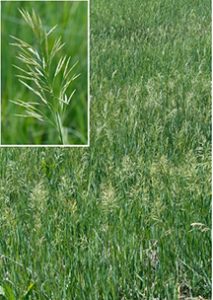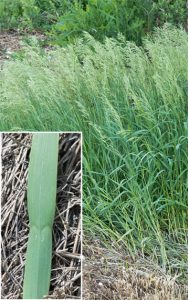Bulletin #2267, Maine Forage Facts: Smooth Bromegrass
Bulletin #2267, Maine Forage Facts: Smooth Bromegrass (PDF)
By Jaime Garzon, Assistant Extension Professor and Forage Educator, University of Maine Cooperative Extension
For information about UMaine Extension programs and resources, visit extension.umaine.edu.
Find more of our publications and books at extension.umaine.edu/publications/.
Smooth bromegrass
Smooth bromegrass (Bromus inermis Leyss) is a tall, sod-forming perennial grass that spreads by short rhizomes. Leaves typically attach to the stem at a sharp, upright angle, and the leaf sheath (the part that wraps around the stem) is closed or continuous. The leaves have a tightened section shaped like the letter “M” about two-thirds of the way to the leaf tip.
This grass is well-adapted to the climate of the northern United States, from Washington to Maine. It is more winter hardy than orchardgrass across this range. Smooth bromegrass will tolerate extremes in temperature and periods of drought, during which it simply stops growing.
Site selection
It is commonly grown as hay or silage with a legume like alfalfa or red clover, where it spreads out as the legume dies. It is not widely grown in Maine because it requires well-drained, deep soils like those required by alfalfa. The best performance is given in well-drained silt-loam or clay-loam soils with 6 to 7 pH. It is relatively tolerant to alkalinity.
Soil preparation and establishment
A moist, firm seedbed is required for smooth bromegrass or bromegrass-legume mixtures. It can be planted in early spring or late summer when weather conditions usually are more favorable. Germinating weeds should be discouraged through light disking several weeks before planting, herbicide application, or other preventative measures.
Seed may be either drilled or broadcast. Drilling is preferred because it provides a more uniform depth of planting. Plant seed ¼ to ½-inch deep. However, long, narrow bromegrass seeds often bridge conventional seed drills and make planting difficult. Alternate seeding methods may help avoid this problem, such as mixing bromegrass seed with a small amount of superphosphate and sowing through the fertilizer attachment of the grain drill or mixing bromegrass with a small amount of oats and sowing through the small grain attachment of your grain drill.
Plant smooth bromegrass alone with a 15 pounds per acre seeding rate or decrease to 4 to 6 pounds per acre when mixed with legumes, using the low rate for seeding with a slow-growing legume like birdsfoot trefoil, a high rate for seeding with a competitive legume like alfalfa. Most hopper-type fertilizer spreaders can be calibrated to broadcast smooth bromegrass seeds. If seeding is broadcast, increase 30% the seeding rate and pass a roller later to increase the soil area in contact with the seeds.
Liming and fertilization
Fertility needs at seeding should be determined by a soil test. Without a soil test and assuming a medium-fertility soil, plow down 0–45–135 pounds per acre and apply 20–20–20 pounds per acre at seeding (banded if possible).
Smooth bromegrass is very responsive to nitrogen fertilization and requires a high level of fertility for maximum production. If you plant smooth bromegrass with alfalfa or another legume, restrict nitrogen applications to 0 to 30 pounds per acre. If smooth bromegrass is grown without a legume, apply 50 to 150 pounds of nitrogen per acre in split applications in early spring when the grass becomes green after each cutting.
If the stand is grazed in the fall, 40 pounds of nitrogen per acre should be applied in late August or early September, with the rest used before the soil freezes in November or December. However, liquid N and urea may volatilize if applied before November or after February. Do not apply manure in Maine fields from December 1st to March 15th.
In addition, excessive fertilization may lead to problems ranging from lodging during harvest to grass tetany and nitrate-N toxicity. The soil of a bromegrass stand should also be tested at least every other year to determine if it has become phosphorus or potassium-deficient.
Varieties
Carlton: Carlton is an improved traditional smooth bromegrass adapted to northern climates. This variety is well-suited for hay and high-yielding, palatable, long-lived, drought-tolerant, and winter-hardy. It matures about the same time as timothy, but the leaves remain soft and green for a longer period. The highest yields are reached in the first cutting. Expect one strong first cutting and a possible fall cutting. Carlton smooth bromegrass can also be grazed but avoid grazing during stem elongation.
Arsenal: Arsenal has greater seedling establishment and persistence than other varieties but less yield. Winter hardy and drought tolerant, Arsenal can be used for grazing and hay. With a high first-cut yield, this variety is usually ready before most early orchard grasses.
Artillery: Artillery is a drought-tolerant, and productive smooth bromegrass. It is rhizomatous and early maturing and was developed from selections from arid regions of Turkey, Iran, Spain, and Mongolia.
Admiral: Admiral is a high-yielding and highly winter-hardy spring forage. It is very palatable with an aggressive regrowth. Dark green in color.
Arid: Arid smooth bromegrass is a new generation developed to be more drought tolerant, less aggressive rhizomes, high yielding, and have good regrowth potential. Due to its high forage yield and quality, this variety is great for hay production or green chop. Developed to be less aggressive than other smooth bromes, Arid works great in pastures with other species too.
Productivity
During spring growth, smooth bromegrass yield is similar to orchardgrass, providing 3 to 5 tons of dry matter per acre for grazing, hay, or silage. If grown in pure stands, nitrogen fertilizer or manure applications will prevent it from becoming sod bound. Regrowth after harvest is much slower than orchardgrass: this is considered a major disadvantage of smooth bromegrass. Like others, the quality of smooth bromegrass drops quickly after seedheads are formed.
Harvest removes most of the growing points, and new tillers or stems must be started from buds on the crown. Before the seedhead is formed, the plant uses carbohydrate reserves for growth; if it is cut during this time, the reserves available to start regrowth are low, and there is a greater chance that the plant will not survive. This is especially true for the first harvest of the year. For these reasons, early harvest or early grazing should be avoided to maintain the stand.
Smooth bromegrass-alfalfa also makes great quality hay. However, the smooth bromegrass may not persist like other grasses in such mixtures. Orchardgrass may be more persistent than smooth bromegrass when mixed with alfalfa. Mixtures of smooth bromegrass and alfalfa are usually cut based on alfalfa maturity and quality. The hay is often clipped too early or too short, removing the smooth bromegrass’s growing point.
Grazing management
Rotational stocking is the best grazing method, particularly with a warm-season grass pasture for summer use. Animals should be concentrated in one pasture for a period determined by forage availability. Such a strategy ensures the use of a greater amount of forage and permits the smooth bromegrass to recover more thoroughly so that the pasture will provide adequate when it is grazed again. It also enables pastures of warm- and cool-season grasses to be used at times of maximum nutrition.
A pasture of mixed alfalfa and smooth bromegrass also has advantages. This combination limits the problems of bloating and short grazing seasons that come with alfalfa and causes better animal performance than a pure, smooth bromegrass pasture.
References
Griffin TS, Coffin D. (2004). Forage facts: growing forage grasses in Maine (Report 2262). University of Maine Cooperative Extension. Orono (ME), United States.
Hall M, Cherney JH. (2005). Smooth bromegrass. Pennsylvania State University Extension. University Park (PA), United States.
King’s Agriseeds Inc. Seed catalog.
Roberts C, Kallenbach R. (2000). Smooth Bromegrass. University of Missouri Extension. Columbia (MO), United States.
Seedway-Growmark Inc. Seed catalog.
Thomas-Murphy J, Amsili J, Bergstrom G, Cherney J, Hansen J, Helms M, Hunter M, Kettering Q, Lawrence J, van Es H, Smith E, Smith M, Stanyard M, Workman K. (2023). Cornell Guide for Integrated Field Crop Management. University of Cornell Cooperative Extension. Ithaca (NY), United States. pp 90–91.
Information in this publication is provided purely for educational purposes. No responsibility is assumed for any problems associated with the use of products or services mentioned. No endorsement of products or companies is intended, nor is criticism of unnamed products or companies implied.
© 2023
Call 800.287.0274 (in Maine), or 207.581.3188, for information on publications and program offerings from University of Maine Cooperative Extension, or visit extension.umaine.edu.
In complying with the letter and spirit of applicable laws and pursuing its own goals of diversity, the University of Maine System does not discriminate on the grounds of race, color, religion, sex, sexual orientation, transgender status, gender, gender identity or expression, ethnicity, national origin, citizenship status, familial status, ancestry, age, disability physical or mental, genetic information, or veterans or military status in employment, education, and all other programs and activities. The University provides reasonable accommodations to qualified individuals with disabilities upon request. The following person has been designated to handle inquiries regarding non-discrimination policies: Director of Equal Opportunity, 5713 Chadbourne Hall, Room 412, University of Maine, Orono, ME 04469-5713, 207.581.1226, TTY 711 (Maine Relay System).



